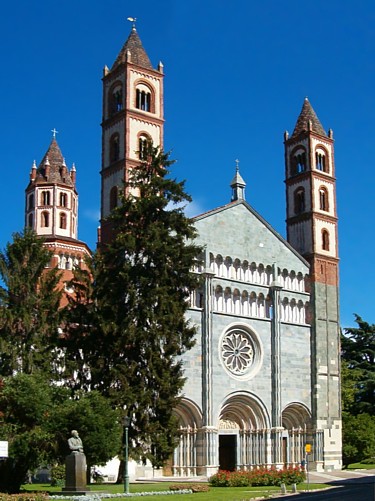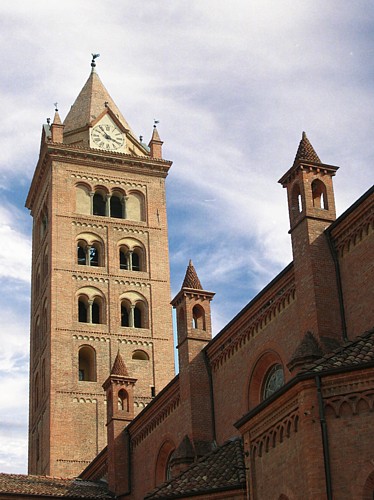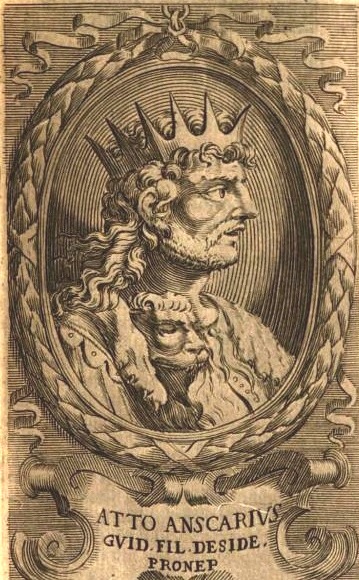|
Margravate Of Ivrea
The March of Ivrea was a large frontier county ( march) in the northwest of the medieval Italian kingdom from the late 9th to the early 11th century. Its capital was Ivrea in present-day Piedmont, and it was held by a Burgundian family of margraves called the Anscarids. The march was the primary frontier between Italy and Upper Burgundy and served as a defense against any interference from that state. History Upon the deposition of the Carolingian king Charles the Fat by his nephew Arnulf of Carinthia in 887, the power in Italy was assumed by the Unruoching margrave Berengar of Friuli, who received the Iron Crown of the Lombards from the hands of Archbishop Anselm II of Milan. Arnulf, King of East Francia marched against Italy to gain the Lombard crown for himself and Berengar chose to pay homage to him, which led to discord with the Italian nobility. They supported the ambitious Duke Guy III of Spoleto, who had just failed to succeed Charles in West Francia, but now ... [...More Info...] [...Related Items...] OR: [Wikipedia] [Google] [Baidu] |
March (territory)
In medieval Europe, a march or mark was, in broad terms, any kind of borderland, as opposed to a national "heartland". More specifically, a march was a border between realms or a neutral buffer zone under joint control of two states in which different laws might apply. In both of these senses, marches served a political purpose, such as providing warning of military incursions or regulating cross-border trade. Marches gave rise to titles such as marquess (masculine) or marchioness (feminine) in England, ''marqués'' (masculine) and ''marquesa'' (feminine) in Spanish-speaker countries, as well as in the Catalan and Galician regions, ''marquês'' (masculine) and ''marquesa'' (feminine) in Portuguese-speaker countries, ''markesa'' (both masculine and feminine) in Euskadi, ''marquis'' (masculine) or ''marquise'' (feminine) in France and Scotland, margrave (german: Markgraf, lit=march count; masculine) or margravine (, feminine) in Germany, and corresponding titles in other Europe ... [...More Info...] [...Related Items...] OR: [Wikipedia] [Google] [Baidu] |
Guy III Of Spoleto
Guy III of Spoleto (german: Wido, it, Guido; died 12 December 894) was the margrave of Camerino from 880 and then duke of Spoleto and Camerino from 883. He was crowned king of Italy in 889 and emperor in 891. He died in 894 while fighting for control of the Italian Peninsula. Guy was married to Ageltrude, daughter of Adelchis of Benevento, who bore him a son named Lambert. Early life Guy was the second son of Guy I of Spoleto and Itta, daughter of Sico of Benevento. Guy I was the son of Lambert I of Nantes and his second wife, Adelaide of Lombardy, who was a daughter of Charlemagne's second eldest son, Pepin of Italy. In 842, the former Duchy of Spoleto, which had been donated to the Papacy by Charlemagne, was resurrected by the Franks to be held against Byzantine catapans to the south, as a Frankish border territory by a dependent margrave. Consequently, Guy’s family had been important players in Italian politics since the early ninth century. Although in 876 Guy and h ... [...More Info...] [...Related Items...] OR: [Wikipedia] [Google] [Baidu] |
Pombia
Pombia is a ''comune'' (municipality) in the Province of Novara in the Italian region Piedmont, located about northeast of Turin and about north of Novara. The commune is known for its Safari Park, established in 1976. History It has Roman origins, when it was called Flavia Plumbia. After the fall of the Western Roman Empire and the Lombardic conquest of northern Italy, it was the seat of a county, later, after Charlemagne's conquest, ruled by Frank Frank or Franks may refer to: People * Frank (given name) * Frank (surname) * Franks (surname) * Franks, a medieval Germanic people * Frank, a term in the Muslim world for all western Europeans, particularly during the Crusades - see Farang Curr ... feudataries. References Cities and towns in Piedmont {{Novara-geo-stub ... [...More Info...] [...Related Items...] OR: [Wikipedia] [Google] [Baidu] |
Vercelli
Vercelli (; pms, Vërsèj ), is a city and ''comune'' of 46,552 inhabitants (January 1, 2017) in the Province of Vercelli, Piedmont, northern Italy. One of the oldest urban sites in northern Italy, it was founded, according to most historians, around 600 BC. The city is situated on the Sesia River in the plain of the Po River between Milan and Turin. It is an important centre for the cultivation of rice and is surrounded by rice paddies, which are flooded in the summer. The climate is typical of the Po Valley with cold, foggy winters ( in January) and oppressive heat during the summer months ( in July). Rainfall is most prevalent during the spring and autumn; thunderstorms are common in the summer. The languages spoken in Vercelli are Italian and Piedmontese; the variety of Piedmontese native to the city is called ''Varsleis''. The world's first university funded by public money was established in Vercelli in 1228 (the seventh university founded in Italy), but was closed in 1 ... [...More Info...] [...Related Items...] OR: [Wikipedia] [Google] [Baidu] |
Turin
Turin ( , Piedmontese language, Piedmontese: ; it, Torino ) is a city and an important business and cultural centre in Northern Italy. It is the capital city of Piedmont and of the Metropolitan City of Turin, and was the first Italian capital from 1861 to 1865. The city is mainly on the western bank of the Po (river), Po River, below its Susa Valley, and is surrounded by the western Alps, Alpine arch and Superga Hill. The population of the city proper is 847,287 (31 January 2022) while the population of the urban area is estimated by Larger Urban Zones, Eurostat to be 1.7 million inhabitants. The Turin metropolitan area is estimated by the Organisation for Economic Co-operation and Development, OECD to have a population of 2.2 million. The city used to be a major European political centre. From 1563, it was the capital of the Duchy of Savoy, then of the Kingdom of Sardinia ruled by the House of Savoy, and the first capital of the Kingdom of Italy from 1861 to 1865. T ... [...More Info...] [...Related Items...] OR: [Wikipedia] [Google] [Baidu] |
Auriate
{{No footnotes, date=June 2020 Auriate was a county in medieval Italy on the eastern slopes of the Western Alps lying between Cuneo and Saluzzo. The county existed from the late ninth century to the middle of the tenth. The name of the county survives in that of the ''comune'' of Valloriate. The earliest known count was one Rodulf, who died in 902, leaving the county to a Frank named Roger, who had been his second-in-command. Between 940 and 945 Roger's son and successor, Arduin Glaber, drove the Saracens from the Val di Susa and annexed that region to his county of Auriate. Arduin was a supporter of Berengar of Ivrea in his successful bid for the Iron Crown of Lombardy in 950. The following year (951) Berengar completed a reorganisation of western Lombardy, creating three new marches to better defend the coast from Saracen attacks: the March of Genoa (Eastern Liguria), the March of Montferrat (Western Liguria), and the March of Turin. Arduin was created the first Margrave of Turin ... [...More Info...] [...Related Items...] OR: [Wikipedia] [Google] [Baidu] |
Asti
Asti ( , , ; pms, Ast ) is a ''comune'' of 74,348 inhabitants (1-1-2021) located in the Piedmont region of northwestern Italy, about east of Turin in the plain of the Tanaro River. It is the capital of the province of Asti and it is deemed to be the modern capital of Montferrat. History Ancient times and early Middle Ages People have lived in and around what is now Asti since the Neolithic period. Before their defeat in 174 BC by the Romans, tribes of Ligures, the Statielli, dominated the area and the toponym probably derives from ''Ast'' which means "hill" in the ancient Celtic language. In 124 BC the Romans built a ''castrum'', or fortified camp, which eventually evolved into a full city named Hasta. In 89 BC the city received the status of '' colonia'', and in 49 BC that of ''municipium''. Asti become an important city of the Augustan Regio IX, favoured by its strategic position on the Tanaro river and on the Via Fulvia, which linked Derthona (Tortona) to Augusta ... [...More Info...] [...Related Items...] OR: [Wikipedia] [Google] [Baidu] |
Alba, Piedmont
Alba ( pms, label=Piedmontese, Arba; la, Alba Pompeia) is a town and ''comune'' of Piedmont, Italy, in the Province of Cuneo. It is one of the main cities in the UNESCO World Heritage Site of Vineyard Landscape of Piedmont: Langhe-Roero and Monferrato. The town is famous for its white truffle and wine production. The confectionery group Ferrero is based there. The city joined the UNESCO Creative Cities Network in October 2017. History Alba's origins date from before the Roman civilization, connected probably to the presence of Celtic and Ligurian tribes in the area. The modern town occupies the site of ancient Alba Pompeia, the name given after being officially recognized as a town by the Roman consul Gnaeus Pompeius Strabo while constructing a road from Aquae Statiellae (Acqui) to Augusta Taurinorum (Turin). Alba was the birthplace of Publius Helvius Pertinax, briefly Roman emperor in 193. After the fall of the Western Empire, the city was repeatedly sacked by Ostrogoth ... [...More Info...] [...Related Items...] OR: [Wikipedia] [Google] [Baidu] |
Acqui
Acqui Terme (; pms, Àich ) is a city and ''comune'' in the province of Alessandria, Piedmont, northern Italy. It is about south-southwest of Alessandria. It is one of the principal winemaking communes of the Italian DOCG wine Brachetto d'Acqui. The city's hot sulphur springs have been famous since this was the Roman town of ''Aquae Statiellae''; the ancient baths are referred to by Paulus Diaconus and the chronicler Liutprand of Cremona. In 1870 Giovanni Ceruti designed a small pavilion, known as ''La Bollente'', for the spot at the centre of the town where the waters bubble up at . History During the Roman period, the region was connected by road with Alba Pompeia and Augusta Taurinorum (Turin) and was populated by the local Celto- Ligurian tribe of the Statielli. The region was subject to Roman rule after their main center, Carystum (Acqui Terme), was attacked in 173 BC by the legions led by the consul Marcus Popilius Laenas. The Statielli did not oppose the resistance, ... [...More Info...] [...Related Items...] OR: [Wikipedia] [Google] [Baidu] |
Liguria
Liguria (; lij, Ligûria ; french: Ligurie) is a Regions of Italy, region of north-western Italy; its Capital city, capital is Genoa. Its territory is crossed by the Alps and the Apennine Mountains, Apennines Mountain chain, mountain range and is roughly coextensive with the former territory of the Republic of Genoa. Liguria is bordered by France (Provence-Alpes-Côte d'Azur) to the west, Piedmont to the north, and Emilia-Romagna and Tuscany to the east. It rests on the Ligurian Sea, and has a population of 1,557,533. The region is part of the Alps–Mediterranean Euroregion. Etymology The name ''Liguria'' predates Latin and is of obscure origin. The Latin adjectives (as in ) and ''Liguscus'' reveal the original root of the name, ''ligusc-'': in the Latin name -sc- was shortened to -s-, and later turned into the -r- of , according to rhotacism (sound change), rhotacism. Compare grc, λίγυς, translit=Lígus, translation=a Ligurian, a person from Liguria whence . The name de ... [...More Info...] [...Related Items...] OR: [Wikipedia] [Google] [Baidu] |
Anscar I Of Ivrea
Anscar I ( la, Anscarius; 860 - March 902) was the margrave of Ivrea from 888Wickham, 178. to his death. From 877 or 879, he was the count of Oscheret in Burgundy. He supported Guy III of Spoleto for the throne of France after the deposition of Charles the Fat in 887, but after Guy's failed attempt and the coronation of Odo, he returned with Guy across the Alps, where the duke was elected King of Italy. In gratitude, he created the March of Ivrea in the northeast and invested his Burgundian supporter. He was a son of the count Amadeus of Oscheret (c. 790–867) of possible Bavarian origin with landholdings also in Tegernsee. Anscar was a counsellor of Boso of Provence and brother of Fulk, who strongly supported the Carolingian dynasty in France. With Fulk, he probably invited Guy to France. Anscar fought on behalf of Guy's kingship in Italy. He battled Arnulf of Carinthia during the latter's invasion of 894 and he supported Guy's son Lambert after Guy's death that year. In 896 ... [...More Info...] [...Related Items...] OR: [Wikipedia] [Google] [Baidu] |






